Spirulina Smart Microfarm
By Robert Henrikson, CEO, Smart Microfarms
Welcome to our Smart Microfarm greenhouse just south of San Francisco. The first spirulina farm in Northern California.
Here we grow spirulina, a blue-green algae, year round, in a controlled environment greenhouse.
All naturally grown. No pesticides, no herbicides, no fungicides, non-GMO. 100% vegetarian.
In a small area, fast-growing microalgae, like the superfood spirulina, can produce higher income than growing conventional food, herbs or vegetables.
Spirulina is harvested several times a week. The fresh harvest collects on a microscreen like a creamy yogurt. It can be frozen or dehydrated.
We package and distribute SpiruSource® fresh harvest, fresh frozen, and low temperature dried crunchies and powder.
These healthy superfoods are sold in select local natural food stores. Also in farmers markets, direct-to-consumer, juice bars and online.
Successful small-scale algae cultivation is now practical. With web-based remote sensors and controls developed by Smart Microfarms, remote experts can guide local operators, without the cost of onsite algae scientists.
This breakthrough, combined with scalable, modular growing systems, means algae microfarms – like this – can be installed anywhere in the world.
Smart algae microfarms are a new opportunity for small scale and urban farming in greenhouses with hydroponic and aquaponic growing systems.
For more, see www.smartmicrofarms.com.
=================================================================
SPIRULINA SMART MICROFARM
First Northern California Spirulina Farm, Half Moon Bay CA
Produced by Robert Henrikson © 2018 Robert Henrikson
www.smartmicrofarms.com www.spirulinasource.com roberthe@sonic.net
Continue Reading | Comments Off on Spirulina Smart Microfarm
Rainbow Grocery Farm Week
Smart Microfarms presented SpiruSource Fresh Frozen Spirulina products during Farm Week at Rainbow Grocery in San Francisco CA. Rainbow Grocery is a well known worker-owned cooperative serving San Francisco and the Bay Area since 1975. (http://www.rainbow.coop/) Along with being a local, independent grocery store, Rainbow is a resource for the community to exchange information about the health and sustainability of the foods we eat. Rainbow is celebrating Cesar Chavez Day by honoring the farm workers and farmers who bring the foods to our tables.

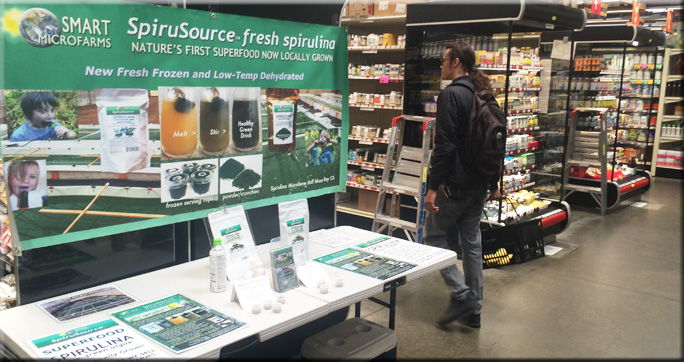
Continue Reading | Comments Off on Rainbow Grocery Farm Week
3D Bioprint Chocolate-Spirulina
3D bioprinting chocolate-spirulina demo party by SE3D.com in Santa Clara California November 30 featured fresh spirulina from Smart Microfarms Half Moon Bay Farm and presentation by Robert Henrikson. Sponsored by SE3D.com for teachers and educators.
Workshop Overview:
Chocolate printing is gaining momentum since the advent of 3D printing technology. Discover how chocolate’s chemistry can affect printability and how you can now integrate 3D printing technology and concepts into your food / bioscience classroom.
Special guest: Robert Henrikson from Smart Microfarm to talk about Spirulina – the Superfood you can’t live without
Discover how you can create a truly guilt-free and healthy chocolate with Spirulina! 3D printed chocolate-spirulina tastes just like chocolate!

Mayasari Lim demonstrating SE3D. Robert Henrikson presenting spirulina.

Spirusource fresh spirulina and chocolate-spirulina snacks. Bioprinting a heart.

A bioprinting food workshop for teachers and educators.
Continue Reading | Comments Off on 3D Bioprint Chocolate-Spirulina
Agriculture: Ancient Ways&Today
Rafael Quezada (Executive Director of The Rootstock Foundation) interviews agriculture experts and explores ancient methods of farming that can be applied to the world’s current industrial agricultural needs. Explores Aquaponics, Spirulina Algae, Cannabis.
This short video documentary about new solutions through aquaponics, algae and cannabis cultivation features an interview at our spirulina microfarm in Half Moon Bay, south of San Francisco and interview with Robert Henrikson at 2:50 – 3:58 minutes.


Continue Reading | Comments Off on Agriculture: Ancient Ways&Today
Sustainatopia Conference
Robert Henrikson presented “Are Algae Microfarms the Future of Urban Farming?”
at Sustainatopia, May 2-4 in San Francisco CA.

The world of Lifestyles of Health and Sustainability (LOHAS), mission-based business, impact investing, social enterprise, and technology will gather this May at Sustainatopia, the premier green business conference. One of the largest conferences in the U.S. for social, financial and environmental sustainability + impact, Sustainatopia offers over 250 speakers from around the country.
This year’s conference offers six tracks:
• Ecosystem of Impact + SRI Investing
• Sustainable Strategies & Innovation (Fortune 500 Companies)
• Clean Technology & Smart Cities
• Empowering Women Through Investment – Health & Impact Tech
• Millennials 100
• Lifestyles of Health & Sustainability (LOHAS)
Continue Reading | Comments Off on Sustainatopia Conference
AIM International Readers Poll Winner
 Smart Microfarms is the winner of Algae Industry Magazine 2015 International Readers Poll in the category “Algae Microfarm”.
Smart Microfarms is the winner of Algae Industry Magazine 2015 International Readers Poll in the category “Algae Microfarm”.
The Algae Industry Magazine International Readers’ Poll mission is to 1. Recognize and reward innovation and excellence, 2. Convey who and what make a difference, 3. Celebrate innovative people, companies, technology.
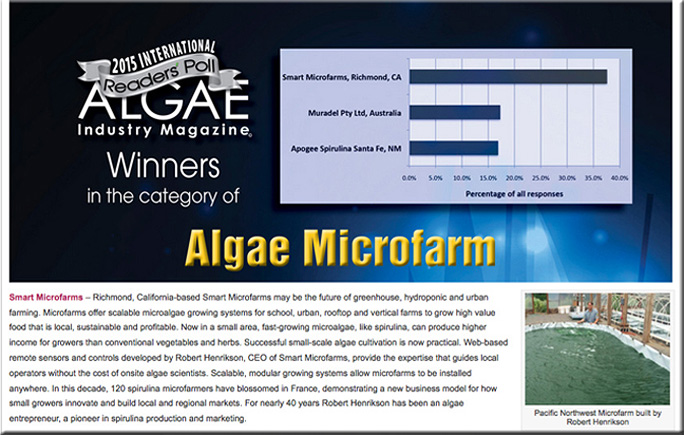
Smart Microfarms– Richmond, California-based Smart Microfarms may be the future of greenhouse, hydroponic and urban farming. Microfarms offer scalable microalgae growing systems for school, urban, rooftop and vertical farms to grow high value food that is local, sustainable and profitable. Now in a small area, fast-growing microalgae, like spirulina, can produce higher income for growers than conventional vegetables and herbs.
Successful small-scale algae cultivation is now practical. Web-based remote sensors and controls developed by Robert Henrikson, CEO of Smart Microfarms, provide the expertise that guides local operators without the cost of onsite algae scientists. Scalable, modular growing systems allow microfarms to be installed anywhere. In this decade, 120 spirulina microfarmers have blossomed in France, demonstrating a new business model for how small growers innovate and build local and regional markets. For nearly 40 years Robert Henrikson has been an algae entrepreneur, a pioneer in spirulina production and marketing.
 Algae Industry Magazine Readers’s Poll Winner in these categories:
Algae Industry Magazine Readers’s Poll Winner in these categories:
Algae Ambassador – Robert Henrikson
Improved Planet Contributions – International Algae Competition
Algae Microfarm – Smart Microfarms
Algae Food, Feed, Nutirents – Smart Microfarms
Algae Cultivation Facility – Earthrise Nutritionals
Continue Reading | Comments Off on AIM International Readers Poll Winner
Help Reset the Algae Industry
November 1, 2015 — by Robert Henrikson
AlgaeIndustryMagazine.com
Yes, push that red reset button to get the algae industry back on track, by nominating players who are making a real and positive contribution in the world of algae.
Over this past decade, the Algae Industry has been dominated by big money chasing the mirage of commercial algae biofuels. My March 2011 post “Shakeout in Algae Biofuels” described shakeout scenarios about to unfold.
This great biofuel boom and bust raked in billions of dollars in government, corporate and private investment over the past decade, attracting charlatans and collaborators (some who knew better) who sucked up the public bandwidth about algae, burned investors, and discouraged many from funding algae ventures for food, feed and high-value products.
Failed biofuel companies may try to excuse themselves because the price of oil fell. A decade ago, experts with real algae experience could not identify a pathway to make algae biofuel cost competitive with conventional fuel even at higher fuel prices. Where is the path forward today?
Just a few years ago corporate suits were dismissing non-fuel products from algae as “co-products” for “niche” markets. Now they are gone. Their replacements at algae biofuel ventures have desperately tried to pivot to those niche markets and algae co-products like food, feed, nutraceuticals, high value oils and fine chemicals, to show a real income stream for their sponsors.
During this time, we have also learned about the barriers to the massive scale required for biofuel commercialization. This undermines the claim that bigger is better, and renews appreciation of small is beautiful.
Algae industry conferences use to open with a plenary panel of algae CEO “all-stars,” touting their big successes developing biofuels. One-by-one they have dropped away. The largest algae industry organization in the USA engaged in ongoing efforts lobbying for government grants, subsidies and entitlements to maintain the faltering algae biofuel R&D industry.
If 10% of the funding for algae biofuels had been directed into R&D for animal nutrition studies and cost reduction for algae aquaculture and animal feeds and human food, we would already be well along on this path. Growing algae for feed and food will have a far greater impact on reducing negative effects of climate change than biofuels ever would, and in doing so, we will support all sentient beings on this Earth.
Let’s reset our algae narrative. There is plenty of good news to share. Opportunities abound. Refocus on the real algae industry that offers real products and services from algae. Let’s nominate individuals and organizations that understand how to change the world. “Eat Algae, Don’t Burn It.”
Continue Reading | Comments Off on Help Reset the Algae Industry
Are algae the greenhouse crop of the future?
 http://www.hortidaily.com/article/17467/Are-algae-the-fresh-and-locally-grown-greenhouse-crop-of-the-future?
http://www.hortidaily.com/article/17467/Are-algae-the-fresh-and-locally-grown-greenhouse-crop-of-the-future?
Algae have the potential to become a cash crop that can provide commercial greenhouse and controlled environment growers with a stable income stream, year round. According to Robert Henrikson, a pioneer in large scale commercial algae production, Spirulina algae is a crop that commercial growers could consider adding to their greenhouse or vertical farm. “I believe greenhouse growers will be the next to incorporate algae microfarms, seeking to diversify into new products with greater income potential.”
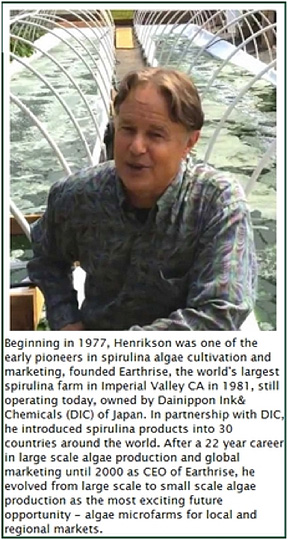
Henrikson’s company Smart Microfarms is currently negotiating production and marketing joint-ventures with commercial greenhouse companies in California to set up spirulina microfarms and deliver spirulina farm-to-table, direct to consumer, and direct to retail. According to Henrikson, Spirulina farming can offer a higher income stream per greenhouse area, good ROI and payback of initial investment within 2-3 years. He explains that Algae can be a great additional crop for vertical farming as well in order to create a better business model.
“Vertical farming is a good initiative, it is sexy, looks exiting and supplies locally grown product direct to the market. Yet, it is a costly way of growing and may not always create the revenues to cover the cost of going vertical. Adding a spirulina cultivation inside a small portion of an existing urban farm or commercial greenhouse farm can change this and add higher income to become more successful.
Spirulina is a high-value food supplement, sold in health food stores for over 30 years, as dried powder, in tablets and capsules. Containing the unique phycocyanin (‘algae-blue’) known for strengthening the immune system, beneficial flora and healing response, and for detoxification, anti-oxidant and anti-ageing properties.
Now with local cultivation, spirulina can be enjoyed in a new way- fresh or fresh frozen –beautiful dark blue-green with almost no taste at all. Customers can melt and blend frozen cubes into juices for green drinks and mix fresh spirulina into dishes and recipes like dips, spreads and hummus. Or sprinkle tasty low-temperature dried spirulina on salads and soups.
Spirulina can be grown successfully in ponds by recreating its natural environment of high pH, alkaline and saline water. Spirulina can also be harvested and used as a supplement for growing fish and aquatic organisms within an integrated aquaponics system.
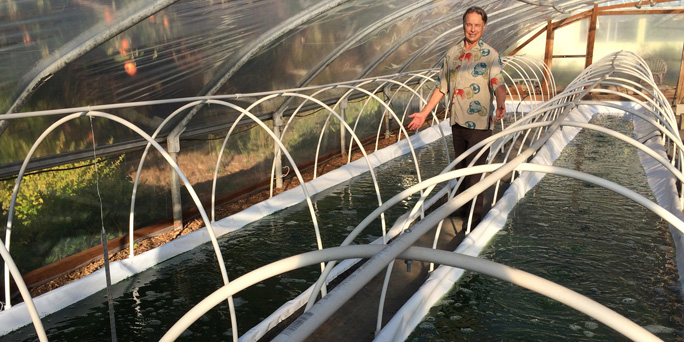
Spirulina ponds in a greenhouse in Olympia, Washington State USA. Spirulina pond systems can fit within larger commercial greenhouses with greens, vegetables, herbs and aquaponic systems.
Currently Smart Microfarms is focused developing business opportunities in the U.S and Canada. However, Henrikson believes this business model is applicable almost anywhere in the world. He hopes to bring microalgae farming to greenhouse and controlled environment growers . “We can design and install practical, affordable and scalable spirulina microfarm turnkey systems, including ponds, circulation, harvesting, processing, freezing and dehydration, products, laboratory. Variations of these microfarms have been deployed and tested. With greenhouse infrastructure in place, growers could be in operation within 6 weeks.”
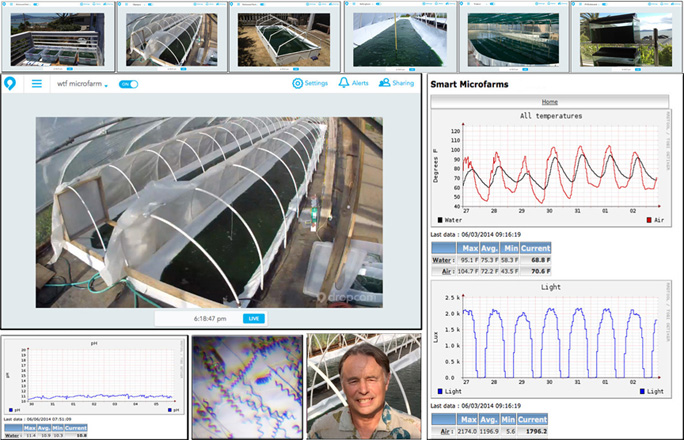
Data and visual displays on a Smart Microfarms monitoring control panel, so remote experts can guide local operators.
Henrikson’s company can also offer innovative web-based remote sensing and monitoring systems to provide ongoing assistance to local operations for successful algae cultivation. “Small operations cannot afford an on-site experienced algae scientist to maintain successful and continuous algae cultures. Real-time web based reporting allows remote experts to guide local operators, reducing culture crashes and downtime. This system has been tested for the past two years in several locations and we are extending its capabilities.”

Fresh harvest and fresh frozen spirulina blended in fresh green superfood juice drinks.
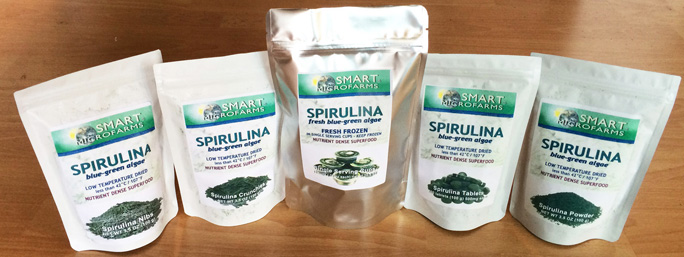
Packaged fresh frozen and low temperature dried spirulina products.
But Smart Microfarms can also help to distribute ‘locally grown’ algae food and supplement products to the local and regional market. “With years of experience developing products, sales and marketing, including connections within the natural foods industry, we can provide an umbrella brand for aggregating the production of small local producers of quality spirulina. We bring to market branded and packaged nutraceuticals and food products sold direct to consumers, online, direct to natural food retail outlets, juice bars and restaurants. Smart Microfarms will source product from its own algae microfarms, other quality algae farms with unique products, and facilitate and develop new farms in its network with technical and marketing expertise, ensuring superior product quality.”
For more information: • Robert Henrikson • roberthe@sonic.net • www.smartmicrofarms.com
Continue Reading | Comments Off on Are algae the greenhouse crop of the future?
The Future of Urban Farming?
Are Algae Microfarms the Future of Urban Farming?
Growing local food in community gardens and urban farms is a popular and growing trend. Because urban space is limited and valuable, some entrepreneurs are transforming old warehouses and even underground spaces into indoor farms using artificial lighting. Others propose vertical farms, even growing food in skyscrapers.
But some scientists calculate that indoor urban farming results in food production with a high cost, high energy use and a big carbon footprint, regardless of whether energy comes from the conventional grid or renewables. They caution indoor food grown with artificial lighting may be less sustainable and more damaging to the environment than food transported from 3000 miles away.
Greenhouses growing food in empty lots or nearby urban areas would be a more cost effective solution. Urban greenhouses would extend the growing season, use existing urban infrastructure, enjoy close access to local markets and customers, and harness the best source of energy – the sun.

Will algae microfarms grow new superfoods for urban and rooftop farms around the world?
What’s coming now is the opportunity to grow high value microalgae to diversify greenhouse food production and significantly enhance revenues.
Over the past 30 years the microalgae spirulina has gained global recognition as a superfood supplement. This productivity breakthrough grows over 20 times more protein than any other conventional food crop on the same area, yet its therapeutic benefits are even more remarkable. Published international research shows how small amounts daily boost immune function, enhance detoxification, restore beneficial intestinal flora, improve neurological function and rally the body’s own healing response. Spirulina commands premium retail prices, $80/lb for dry product in the USA, €150/kg in France. Where fresh frozen product is available locally, even higher prices.
Most people think of large algae farms located in hot sunny desert or tropical locations. But in this past decade, over 110 algae greenhouse microfarms have spread across France. In the USA, spirulina is being successfully grown in greenhouse microfarms in the northern climate of the Pacific Northwest.
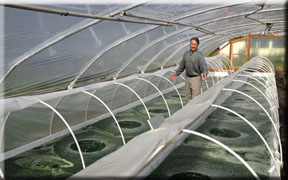
< Algae growing ponds have retractable and removable greenhouse covers. In cooler seasons, ponds are covered at night to retain warmth. In summertime, covers are completely removed.
These new algae microfarms are modular and scalable greenhouse systems with smart monitoring systems and web cameras so remote experts can successfully guide local operations at many locations simultaneously. With insulated ponds and efficient LED lighting and heating systems, the algae growing season can be extended in northern climates well beyond the typical short 4 or 5 months.
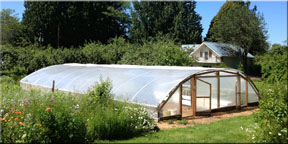
< The first Pacific Northwest spirulina microfarm near Olympia Washington. This eco-region has a temperate rainforest climate with warm sunny summers and wet cloudy cool winters.
Smart Microfarms’ CEO Robert Henrikson founded one of the world’s first and largest algae farms, Earthrise Spirulina in Southern California, 35 years ago. He explains his own evolution from large to small farms. “For decades, algae have been grown on large commercial farms with extensive technical staffing and infrastructure. Now the time has come to introduce algae microfarms to grow healthy foods in local communities. Profitable business models already exist.”
The Pacific Northwest algae microfarm testbed will develop metrics for microfarm operations and productivity especially for temperate climates. They will test practical, affordable and replicable systems for growing algae for local food and high value products in community, urban, rooftop, mobile and vertical gardens to demonstrate how microfarms can transform small food growing area into generating more income.
Smart Microfarms can help terrestrial, hydroponic and aquaponic greenhouse farms diversify income stream with high-value algae food products.
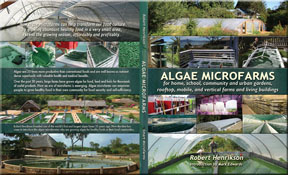
“Algae Microfarms”, the new book by Henrikson, available at Amazon.com, features individuals and organizations around the world growing algae on a small scale and making a difference today.
Some of these small farms are humanitarian, some are commercial, some are both. The book is a look into our future of scalable microalgae systems for home and community gardens, urban and rooftop farms and even living buildings.
Spirulina Algae Microfarm near Olympia Washington.
The first Pacific Northwest spirulina microfarm is located near Olympia Washington, a temperate rainforest eco-region with warm sunny summers and wet cloudy winters. Algae are harvested through a micro screen several times a week during the growing season. This smart microfarm testbed will show how algae microfarms generate income from a small area.
2:00 minute video of Spirulina Algae Microfarm near Olympia Washington (2013).
Continue Reading | Comments Off on The Future of Urban Farming?
Microfarms for Rooftop and Urban Farms
Algae farms are often located in hot sunny desert or tropical locations, but new spirulina algae microfarms in the Pacific Northwest are testing features for growing algae in more northern temperate climates.

< Algae growing ponds have retractable and removable greenhouse covers. In cooler seasons, ponds are covered at night to retain warmth. In summertime, covers are completely removed.
Growing local vegetables in gardens and rooftop farms in urban areas around the world is a popular trend. Many urban farms use greenhouses with hydroponic and aquaponic systems to extend the natural growing season. Now high value microalgae, like spirulina, can diversify greenhouse food production and enhance revenues.

Will algae microfarms become new food crops for rooftop farms in cities around the world?
Over 30 years spirulina algae has gained global recognition as a superfood supplement. Published international research shows how consuming small amounts boost immune function, enhance detoxification, restore beneficial intestinal flora, improve neurological function and rally the body’s own healing response. For these reasons spirulina commands premium prices.

< The first Pacific Northwest spirulina microfarm near Olympia Washington. This eco-region has a temperate rainforest climate with warm sunny summers and wet cloudy cool winters.
These new algae microfarms are modular and scalable greenhouse systems with smart monitoring systems and web cameras so remote experts can successfully guide local operations at many locations simultaneously. With insulated ponds and efficient LED lighting and heating systems, the algae growing season can be extended in northern climates well beyond the typical short 4 or 5 months.
Smart Microfarms’ CEO Robert Henrikson founded one of the world’s first and largest algae farms, Earthrise Spirulina in Southern California, 35 years ago. He explains his own evolution from large to small farms. “For decades, algae have been grown on large commercial farms with extensive technical staffing and infrastructure. Now the time has come to introduce algae microfarms to grow healthy foods in local communities. Algae microfarms are simplified and affordable systems with lower cost of entry, and can be enhanced by automation and web-based monitoring systems to reduce the need for experts on site. Profitable business models already exist.”
The Pacific Northwest algae microfarm testbeds will develop metrics for microfarm operations and productivity especially for temperate climates. They will test practical, affordable and replicable systems for growing algae for local food and high value products in community, urban, rooftop, mobile and vertical gardens to demonstrate how microfarms can transform any small food growing area into higher income generating food products.
Smart Microfarms can help terrestrial, hydroponic and aquaponic greenhouse farms diversify income stream with high-value algae food products.
Continue Reading | Comments Off on Microfarms for Rooftop and Urban Farms

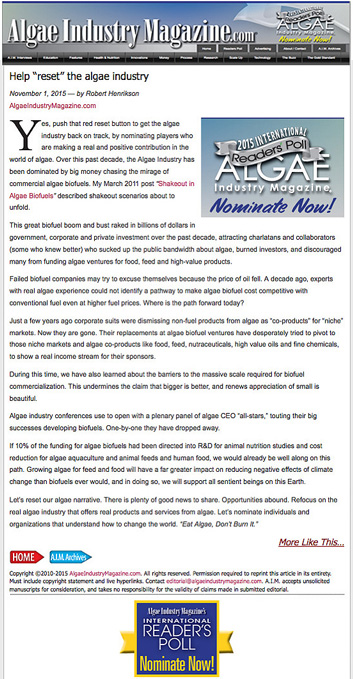


 SPIRULINA
SPIRULINA